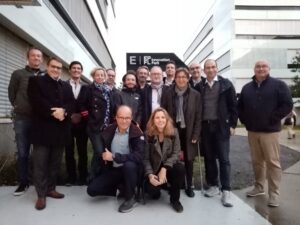💡 Let’s talk LOM (French mobility orientation law)
💡 Let’s talk LOM (French mobility orientation law)
by Joëlle Touré & Lesley Brown, Futura-Mobility
At long last! In December 2019, the French National Assembly passed the long time coming Mobility Orientation Law (loi d’orientation des mobilités, LOM). This new legislation seeks to make everyday transport more accessible, better adapted to the diversity of needs, and cleaner. “We are making deep-seated changes to improve mobility for all and in all [the French] regions, and to kick-start the ecological transition of our transport,” said Elizabeth Borne, minister for the ecological and inclusive transition.
The (video) conference organised by the think tank Futura-Mobility, on 2 June 2020, was an opportunity to explore the main impacts of the LOM in terms of governance and on the ground.
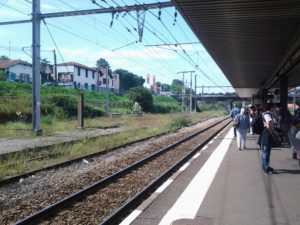
Governing mobility
“What the LOM is taking on has been in the making for a long time,” explained Mariane Thébert, research fellow at Laboratoire Ville Mobilité Transport, Gustave Eiffel University. By reviewing the legislative framework for transport since the 1980s, she revealed how this law is indeed the fruit of decades of debate and reflection.
A first phase of legislative developments took place between 1982 and 2010. It began with the LOTI (1982), the founding act for organising transport “that decentralised the sector but paid scant attention to governance and even less to mobility,” pointed out Ms Thébert. Next came several laws (notably the Grenelles I and II in 2009-2010) that sought to integrate the need for sustainability into the legislative arsenal, i.e. greening mobility and territorial planning tools. “During this period, we shifted from the right to transport established by the LOTI to the right to breathe air that isn’t harmful to health,” explained Ms Thébert.
Also during this time, especially with the SRU legislation in 2002, the idea took hold that not every type of mobility is good mobility, that some types may even prove undesirable: mobility generated by urban expansion, for instance.
Responding to these challenges, the legislator took action on urban transport coordination by trying to create a maximum of links between urban and mobility planning. It also started acting on the multimodality of urban transport organising authorities (called AOTU at the time) by giving them new powers, for instance, over self-service bike services, over roads with dedicated public transport lanes …. The AOTUs were also authorised to allocate carsharing labels. This extension of prerogatives beyond the field of transport to the diversified field of mobility heralded the legislative consolidation of the decade to come.
The second phase of this legislative development started in 2014 with the MAPTAM law and culminated with the LOM. The challenge here was to “clarify the distribution of powers between public stakeholders, while dealing with the increase in private companies entering the new mobility market.” The aim being to boost public action powers at regional and intermunicipal levels, particularly in the mobility sector.
The creation of mobility organising authorities (AOM) completed the extension of their powers to include new mobility services (carsharing, carpooling, self-service vehicles, etc). In parallel, no longer using ‘urban’ when talking about mobility – the scope of urban transport now being replaced by the territorial jurisdiction of the AOM – acknowledged the diversity of the territories over which the power was exercised, and hence the diversity of the mobility solutions to be introduced. “This was by no means neutral because it meant an AOM could develop non-urban transport within its powers,” continued Ms Thébert.

Multilayered?
Over the years, the development of mobility policies has come up against recurring challenges. Organisational and operational silos, for instance, have hindered a multimodal approach. Transport powers were, in fact, extremely fragmented between different levels, depending on the modes in question (rail, road, etc.), and between the different services at the same level. “This has changed over the past decade or so because we now have ‘journey’ services that have adopted this multimodal approach,” assured Ms Thébert.
The sectoral division of public policy remains another challenge: “If, on the one hand we are trying encourage modal shift, yet, on the other, encouraging urban sprawl, we running up against a contradiction. Likewise for the coinciding of functional and institutional boundaries: “The legislator always wants to extend the institutional scope,” said Ms Thébert. “As soon as people move to the outskirts of cities they are beyond the institutional boundaries of organising authorities, so what do we do for them in terms of mobility?”
In response, the LOM is reorganising the governance of mobility to ensure extensive coverage of the AOM territory. “Municipalities must transfer their mobility powers to their intermunicipality. So within the next year, around 900 of the 1,000 existing community municipalities must take a decision about mobility powers or hand them over to the Region, which is legally competent.” The boundary is thus extended. Once the AOM has been identified, it can sign “operational mobility contracts for mapped catchment areas.”

Data exchange and Mobility as a Service (MaaS)
What has transformed the mobility landscape over the past ten years? Without a doubt, the development of digital services – with the arrival of smartphones, and data capture as a consequence – plus the emergence of new operators and transport modes.
Further still, the LOM aims to accelerate the opening up of data and development of digital services. Already an obligation for organising authorities (AO) imposed by the ‘Macron Law’ in 2015 and European legislation (MMTIS regulation of 2017), the LOM affirms, steps up, and facilitates this move towards open data. “The bottom line for article 25 is that all the AOs (‘métropoles’, community municipalities or intermunicipalities) are required to open up data on all existing modes,” summed up Nicolas Pélissier, assistant director for local authorities and institutional relations, Keolis.
From now on, the Regions are charged with coordinating the opening up of data and the transport regulatory authority (ART) with monitoring and settling disputes. Data must be disseminated either statically (a file) or dynamically via an API (programming interface) on the National Access Point (NAP), transport.data.gouv.fr. This NAP collects the data and shares it with re-users. “There’s still some debate in this area,” explained Mr Pélissier. “Because by providing their data via this NAP, the AOs are incapable of disseminating or controlling the dissemination of their own data.”
Moreover, with the LOM, AOs must now ensure MaaS exists to facilitate intermodality across all transport modes. They are also required to provide a digital interface accessible to parties offering MaaS services. Also new in the LOM is the definition of two legal categories of digital services for information, reservations and selling mobility services:
– the ‘contact platform’, which simply allows parties to deliver their own fare products;
– the ‘distributor’, which can, if the AO agrees, set the price a) for selling its own fare products and b) for reselling those of the transport operator. This means the ‘distributor’ could even create a different price!
Regarding the latter category, Mr Pélissier voiced his concerns over “a risk of disintermediation of operators and, above all, of a private party capturing all the data and hence the value.”
Taking into account all the measures in the LOM for MaaS, “everything’s not going to be in place tomorrow. The law is probably sufficiently complex and ambiguous to slow down the introduction of MaaS.”
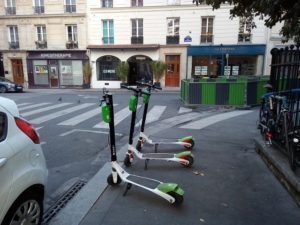
Boosting innovation
To encourage new mobility in terms of both user acceptability and its integration with existing systems, the LOM places great emphasis on innovation.
Articles 30 to 39 make provision for obligations and orders such as the supervision of free-floating services supported by AOs, a legal framework for autonomous vehicles, the possibility of introducing dedicated lanes for ‘extremely low emission vehicles’, supervision of carpooling, and users’ rights.
French mayors were undoubtedly relieved to discover article 51 of this ‘innovation’ part of the LOM. It provides a clear framework for micromobility, particularly electric scooters (e-scooters) and free-floating bikes, that up until now has been sorely lacking. Non-motorised ‘personal mobility devices’ (PMDs) like kick scooters, rollerblades, and skateboards have been assimilated with pedestrians so are now subject to the same rules. Motorised PMDs such as hoverboards, monowheels, gyropods, and e-scooters are now likened to bicycles, must use cycle paths or greenways, so must abide by the same cycling rules;
With article 53, the LOM imposes a change for transport operators, like Keolis, designed to facilitate bike-coach intermodality for passengers. “What’s original here is that new coaches must be equipped with a system for carrying at least five non-dismantled bikes by 1 January 2021,” explained Mr Pélissier.
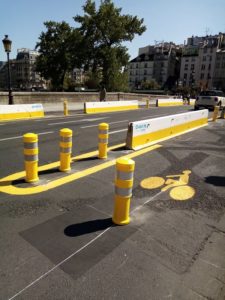
Cleaner and more active mobility
Pollution, congestion, the energy transition …. Governments, cities, planning authorities, urban planners, manufacturers, and transport operators are currently under huge pressure to develop and support cleaner and more active mobility.
“When the LOM was deliberated by the Assembly and Senate, there was long and impassioned debate over motorisation – petrol, diesel, natural gas, electric?” recalled Mr Pélissier. “There were long discussions on how to regulate, what should be encouraged but not too much, how to incentivise ….”
As a result, article 73 contains objectives for decarbonising land transport. It proclaims a ban on sales of passenger cars and light commercial vehicles running on fossil fuels (petrol, diesel, natural gas, etc) by 2040. They will even be outlawed from the roads by 2050.
“It’s quite drastic,” reacted Mr. Pélissier. “What is written down by one law can tomorrow be undone by another. It’s not impossible for this provision, at least that’s what I predict.” In particular, he is unhappy about what he considers to be extremely short time slots between now and 2040, and then 2050, to design new vehicles, to innovate … in short, to achieve this radical shift in the market. “It takes many years, for car manufacturers like Renault and Peugeot. These are really tough obligations!”
At the same time, other measures seek to make companies and their employees take greater responsibility. Article 77, for instance, sets a minimum percentage of low-emission vehicles (LEVs) for companies with fleets of over 100 vehicles: 10% renewal by 2022, 20% by 2024, and 50% by 2030. On the employee side, the LOM provides for the creation of a sustainable mobility flat rate (article 82) for people travelling to work by bike, carpooling or free-floating.
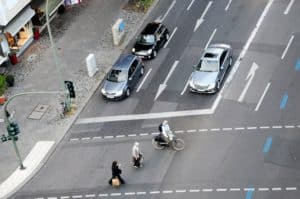
Change in the air?
With its 200 articles, the LOM is aiming high. Maybe too high according to some. Indeed, questions still hang over the resources needed to enforce the bill – both financial and human. The measures written in the text are not set in stone, either. “Given the current context with Covid-19, it’s quite possible what has been adopted might change, be postponed or adjusted,” acknowledged Mr. Pélissier.
Nevertheless, with this new law and those that have come before, Ms Thébert is convinced “the legislator has really tried to organise governance of mobility on a par with the mobility represented in our society.”
From transport to mobility
Although the LOM has yet to prove its worth, its ambitions illustrate how the vision of mobility has changed. According to Ms Thébert, the focus, technical, on travelling from point A to point B, has shifted towards an understanding of the “mobile individual” who is agent of their own movements.
Today, mobility is recognised as a broader topic involving lifestyles, the organisation of society and territories, and mobilising many disciplines. “The change in terminology between the LOTI and the LOM (from transport to mobility) is not simply out of pleasure for words; it corresponds to a real paradigm shift,” concluded Ms Thébert.
Cover photo: Gerd Altmann – Pixabay

